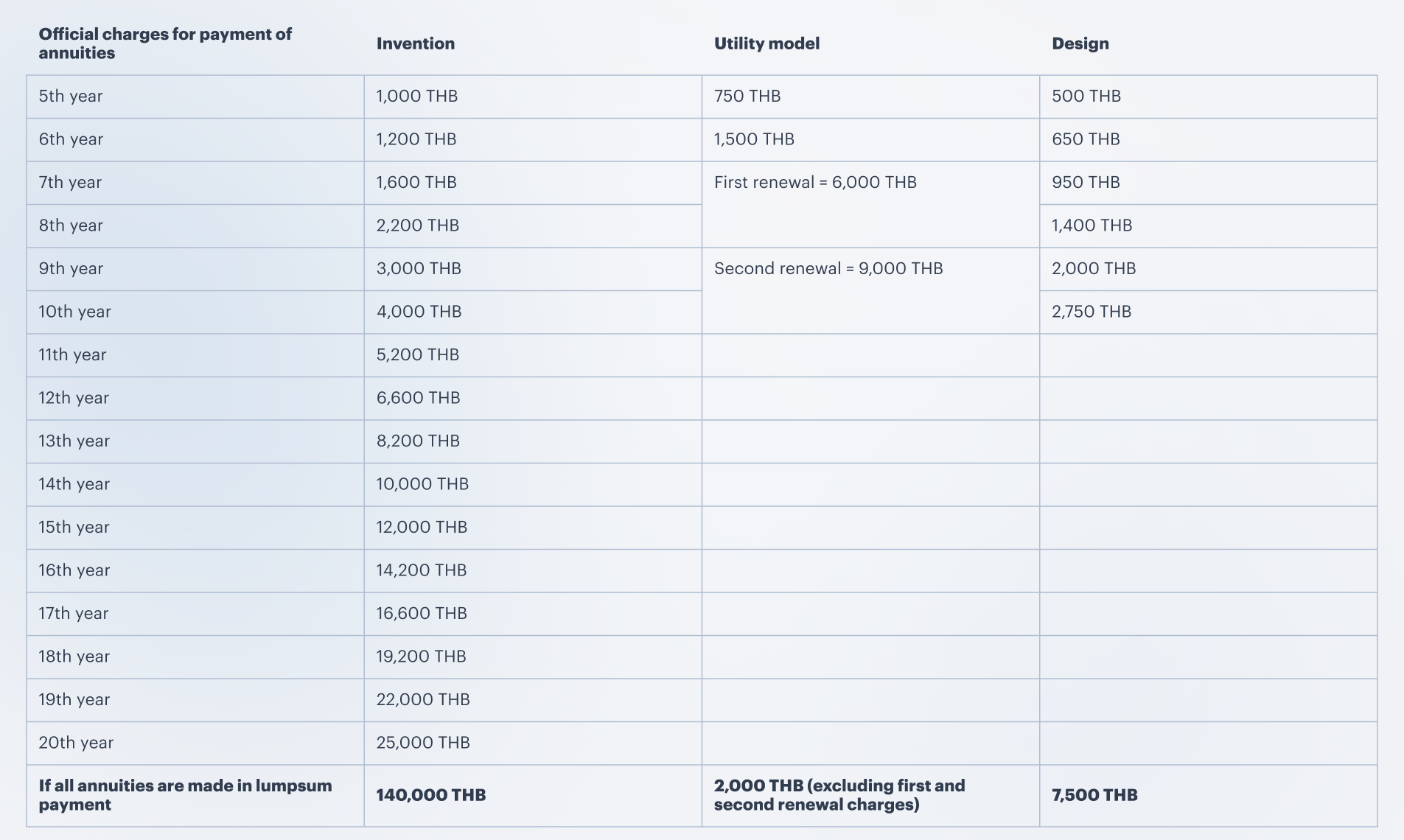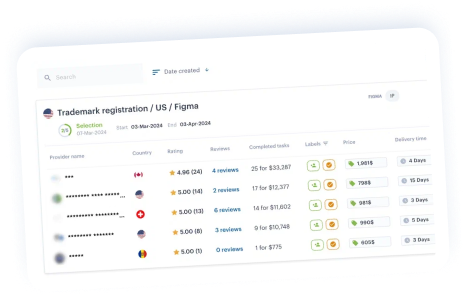Authors: Franck Fougere; Plaifon Pornpunyalert, ANANDA INTELLECTUAL PROPERTY,
Content
3. Reasons for Refusal of an Application
4. The Patent Registration Process
5. Documents Required to Register an Application
8. Why File an Application in Thailand?
Introduction
In Thailand’s rapidly evolving economy, patent registration has become a critical asset for businesses and individuals to gain leverage in the market. By obtaining IP protection, businesses can safeguard their novel inventions and technological advancements and earn the exclusive rights to use and/or license the inventions.
Applications are filed with the Department of Intellectual Property (DIP), Ministry of Commerce. The number of applications filed has been fairly consistent in the past five years, with approximately eight thousand invention applications filed per year. Foreign applicants account for 90 percent of the filings as the country is continually being seen as one of the business hubs in Asia, in particular Southeast Asia.
This article outlines the patentability requirements, invalidation process and grounds for a refusal in Thailand.
What Can Be Registered?
Any invention that is (i) new, (ii) inventive (not applicable for petty and designs), (iii) has industrial applicability, and (iv) does not fall under unpatentable subject matters can be registered.
Unpatentable subject matters are listed under section 9 of the Thai Act as follows:
- naturally occurring microorganisms and their components, animals, plants or extracts from animals or plants;
E.g. The purification process of naturally occurring microorganisms is considered a discovery only. However, if the microorganism had been genetically modified to create a new strain of microorganism then it would be eligible for the invention or the utility model. - scientific or mathematical rules or theories;
- computer programs;
E.g. while software is not patentable, hardware is patentable. - methods of diagnosis, treatment or cure of human and animal diseases;
E.g. Although Swiss-type claims were permitted in the past, the Thai examiners have been increasingly strict on such types of claims. - inventions contrary to public order, morality, health or welfare.
Reasons for Refusal of an Application
The examination procedure is conducted in two stages – formality and substantive examination. A refusal decision from the Examiner may be issued at both stages.
Listed below are some of the common reasons for the refusal of an application.
Common rejection for patent registration based on formality grounds:
- Description – not containing all the required subheadings; not disclosing invention in a full, clear and concise manner in a way that enables an ordinary skilled person in the art to make and use the invention etc.
- Claims – contain unpatentable subject matters; not supported by the description; not clear and concise as to what is claiming e.g. use of the word “about”; not referring to the preceding claims in an optional manner; claiming more than one invention in a single claim etc.
- Abstract – contains more than 200 words; not indicating the main technical features of the invention but drafted in an advertisement manner etc.
- Drawings – not submitted in B&W; not depicted the invention clearly etc.
Common rejection based on substantive grounds:
- Novelty – parts of the invention are not new and the claims need to be narrowed down in scope to claim only the features that are considered novel;
- Inventive step – whole or parts of the invention are obvious to the skilled person in the art in light of the prior arts and the applicant is required to submit argument and evidence to prove that the invention is not obvious to a person skilled in the art or the applicant may choose to narrow down the scope of claims to claim only the features that are considered inventive.
For both types of rejections, the applicant will have the opportunity to amend the application to comply with the law and examiner’s request.
The Patent Registration Process
INVENTION
Invention can be filed through two systems:
- a national application (first filing or within 12 months of a priority application filed in another country); or
- an application under the PCT system which makes it possible to seek the protection:
- for an invention and other PCT Contracting States, as selected, in an “international application” filed with the Thai Department of Intellectual Property (DIP) or the International Bureau of the World intellectual Property Organization (WIPO); or
- to seek the protection for an invention already filed under an international application filed in another PCT Contracting State or with the International Bureau of the WIPO (the so called “National Phase”).
Whether the application is filed under the national or international system, the application is first required to include a detailed description of the invention to enable persons skilled in the art to understand and create such an invention and filed online. The description must also include a description of the best mode to perform the invention; such a description is not always required in other countries.
The application shall then contain an abstract, a title, drawings to support the description (if applicable) and claims.
The claims must be clear and concise so as to clearly identify the exclusive rights of the patentee over the invention.
Below is a simplified overview of the national procedure for inventions.

Invention protection procedure (national application – simplified)
The duration of examination for invention applications is one of the largest hurdles for applicants, taking around 6-10 years. The expedition of examination process is available for applications with granted corresponding inventions in other jurisdictions.
PETTY PATENTS
Petty patents (also called utility models in other countries) offer a good alternative to invention. They provide protection for inventions which are new and capable of industrial application but do not possess a non-obvious, inventive step. In exchange for the more lenient requirements, utility models are protected for only 10 years, compared to the invention’s 20-year protection period.
Utility models are popular, especially among companies that do not require a protection exceeding 10 years.
Utility models are usually granted within one year and a half from date of filing as examiners only perform a formality check. A request for a substantive examination is not required.
Below a simplified overview of the national protection procedure for utility models.

Utility models protection procedure (simplified)
DESIGN
Designs are very popular, among both foreign and Thai applicants alike. The purpose of a design is to protect the ornamental aspects or aesthetics of an article including features pertaining to the shape, configuration or pattern.
Under Thai law, each design application may contain one design. Therefore, IP holders who wish to protect more than one embodiment of a design, such as an alternate or complementary pattern scheme, must file a separate application for each embodiment.
It is important that the application includes depictions of the design from several perspectives, both two-dimensional and three-dimensional, such as: front view, back view, right view, left view, bottom view, top view and perspective view.
These views can be either drawings or pictures of the product.

Design protection procedure (simplified)
Documents Required to Register an Applicatio
The formal documents required for filing an application are as follows:
- Notarised Power of Attorney appointing a registered Thai Agent;
- Statement of Applicant’s right if the applicant is the same person as the inventor;
- Deed of Assignment assigning the right to file an application from the inventor to the applicant (applicable for non-PCT filing only).
The above documents are required to be translated into Thai language with a certified translation.
Other documents which needed to be translated into Thai language are specification, RO101, IB306 etc.
Invalidation Process
For invention, a third party may oppose an application during pre-grant and/or post-grant. The process for pre-grant opposition is initiated at the Thai DIP and the process for post-grant invalidation is initiated at the Central Intellectual Property and International Trade (IP&IT) Court.
The common grounds for the invalidation are:
- The invention lacks novelty;
- The invention lacks inventive steps;
- The invention is incapable of industrial application;
- The invention contains unpatentable subject matter;
- The patentee did not have the right to file the application e.g. not the true inventor;
- The applicant is not a qualified person e.g. a non- Thai national/resident and a non-WTO national/resident.
Pre-grant opposition
Any person who believes that they have a better right to an application or believes that the applicatioin concerned falls under the afore-mentioned grounds can file an opposition within 90 days from the publication date of the concerned.
The applicant must respond to the opposition within 90 days and submit the evidence within 120 days for the Director-General’s consideration, otherwise the application will be deemed abandoned.
The applicant or opposing party can appeal the decision of the Director-General to the Board within 60 days from receipt of the decision and can further appeal the decision of the Board to the IP&IT court within 60 days from receipt of the Board decision.
Post-grant invalidation
Once an application has been granted, an invention can only be invalidated through filing invalidation claims at the IP&IT Court. The Court generally renders a first instance decision within 18-36 months. The decision of the court of first instance may be appealed to the Appellate Court and the Appellate Court’s decision may be appealed to the Supreme Court.
The above opposition and invalidation procedures apply to invention only as the utility moderl has post-grant opposition procedure which allows any interested party to request the examiner to examine the novelty and industrial applicability of the invention within one year from the grant publication date.
IP Rights Protection Costs
Under the current Act (Act B.E. 2522), the official cost payable to the Thai DIP are as follows:

Annuity payment is payable upon grant from 5th year onwards. The official charges are as shown in the table below:

Whether you are a company or an individual, join iPNOTE to find the lawyer and get filing service shortly.
Why File an Application in Thailand?
The main benefits for filing an application are as follows:
- Exclusive rights for owner to make, use, sell, distribute, and commercialize the patented invention or design without competition;
- Enforceability of granted rights; the owner can prohibit others from using the patented invention or design during the life of the invention/design/utility model;
- Exclusive source of revenue when properly commercialized including licensing;
- Earn trust from clients/customers and be positioned as the innovative leader in the field.
Conclusion
To make the country an attractive investment destination for businesses, the Thai Government aims to align the country’s intellectual property protection with international standards. The efforts have been made in both the enforcement and legislative front. In safeguarding IP rights holders, the government rigorously cracked down on counterfeited goods and destructed around 1.2 million counterfeited goods in 2024, while prosecuting over a thousand of lawsuits against the IP rights infringers. The custom recordation system has also been adopted to stop the IP infringed products from entering the country.
At a policy level, the country is in the process of reforming the law to address many pitfalls ensued from the current Act, some of the most prominent being the delay in examination process and lack of provisions and clarifications on many procedures. Under the new law, the duration of design protection will be increased to 15 years.
With the Thai government’s efforts to align IP protection with international standards, businesses can confidently safeguard their IP protection in the country and ensure that they remain competitive in an ever-evolving market.






